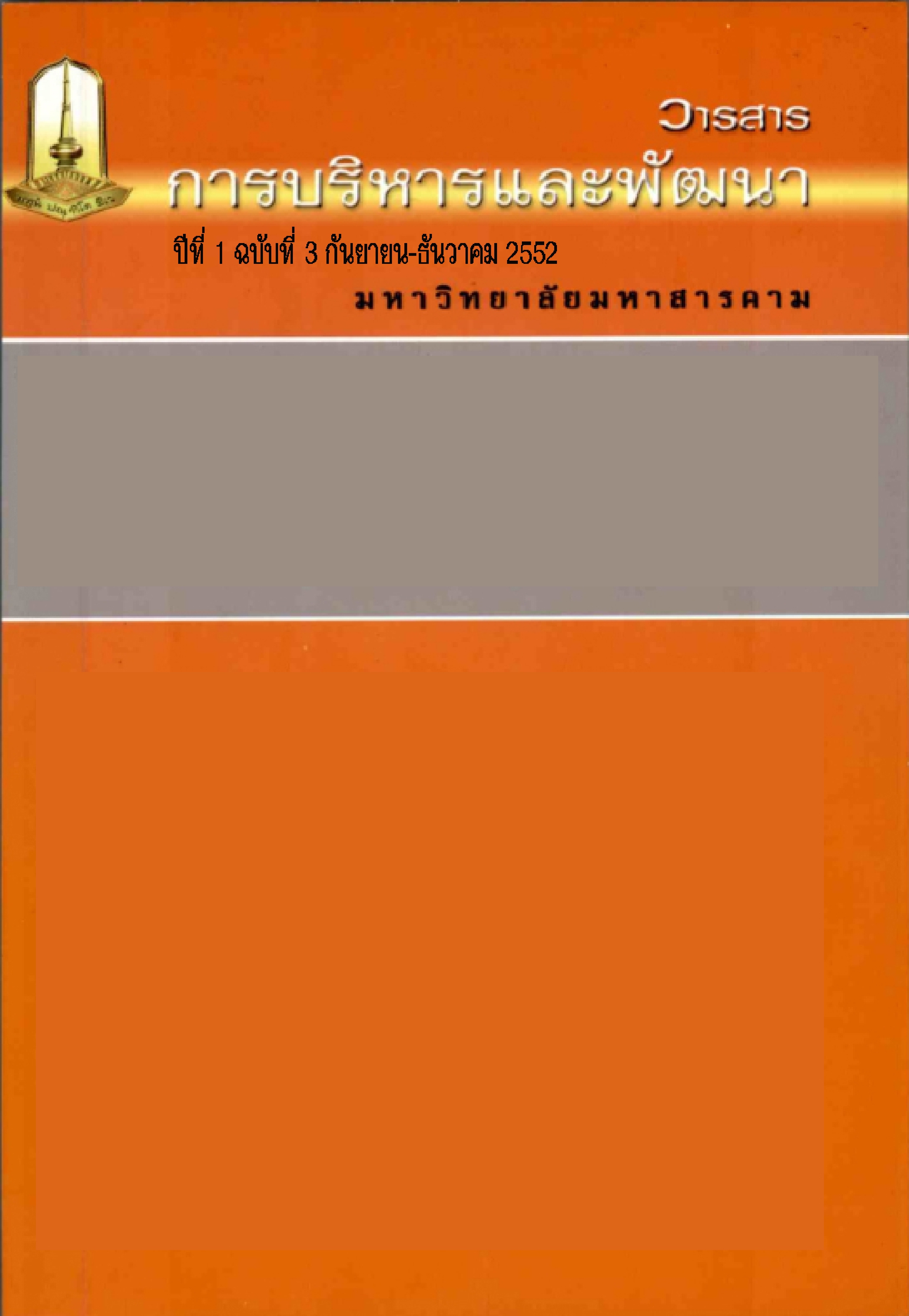Developing a Model of Learning from Learner-Centered Action
Main Article Content
Abstract
The Purposes of this study were to: 1) develop a model of learning from learner-centered action of Master of Education degree Program in Educational Administration students, 2) examine effects of using the model of learning from learner-centered action from teaching the education Provision for Local Development Course, 3) examine the Master of Education Program students’ satisfaction with the quality of teaching of the instructor and with the teaching aids, and 4) examine factors of success of results of learning from learner-centered action of learning and teaching. A group of research participants consisted of 46 Master of Education degree Program in Educational Administration students enrolled at Si Sa Ket Educational Service Center in the first semester of the academic year 2009. The research methodology used was the research and development research by applying participatory action research together with plans for organization of learning activities, a series of book in supplement to Education Provision for Local Development Course, Video, an achievement test with discriminating powers ranging .20-1.00 and a reliability of .80, an after action review, note-taking from, a questionnaire on student’s satisfaction with instructor’s teaching quality, and issues of focus group discussion on an analysis of factors of success in organization of learning of the course. The statistics used were percentage, mean, standard deviation, effectiveness index, and t-test were as follows:
1. In developing the model of learning from learner-centered action by implementing the methods of learning by action of Marquardt(1999) in developing plans for learning together with learner-centered action, and development of learning from learner-centered action of Chantarasombat (2009) in analyzing and making stages of participatory action research and plans for organization of learning activities through 5 experts, the following were found: (1) The model of learning from learner-centered action as a whole was appropriate at the highest level. (2)The practical feasibility of the model of learning from learner-centered action as a whole was appropriate at the highest level. (3) The congruence of the model of learning from learner-centered action together with the plans for organization of learning activities was also appropriate at the highest level.
2. For the efficiency of the model of learning from learner-centered action in participatory action research at 6 stage and using the model together with organization of learning activities in 13 sub activities, the following were found: 1) The efficiency of the developed plans for learning from learner-centered action as a whole was 84.86/78.14 which was in conformity with the standard established requirement of 80/80. 2) The effectiveness index of the plans for learning from learner-centered action as a whole was .5392, showing that the learner increased their knowledge from before learning at 53.92 percent. 3) The learners’ learning achievement mean scores before and after learning were different at the .05 level of statistical significance. 4) After learning and 2 weeks after learning the learners had different learning retention mean score at the .05 level of statistical significance, showing that the learners still had learning retention.
3. The Master of Education Program students’ satisfaction with the instructor’s teaching quality and learning aids in the Education Provision for Local Development Course as a whole was at the highest. When each aspect was considered, it was found that their satisfaction was also at the highest level in each of these aspects: content, instructor’s teaching skills(in theory), instructor’s teaching skills(in practice) instructor’s characteristics, measurement and evaluation, instructor-student relationship, and learning aids respectively.
4. After using participatory action research together with plans for organization of learning activities, there were 6 major factors of success of the results of organization of learning from learner-centered action: 1) participation in action, determining needs, goals, and measurement and evaluation of learning in this course from the beginning; 2) awareness, positive attitudes, responsibility for the course being learned in individual and group work; 3) intention to act to achieve the established agreement; 4) learning climate, the instructor being facilitator to stimulate learning in all sides throughout the program, having series of course books, media and tools for study, note-taking on accounts of after action review(AAR), having examples of case studies from the previous batches of students to comp are the quality of works; 5) evaluation, summarization of work operation in the results from the model of learning from real learnercentered action for learners in knowledge, feelings and skills in field study; and 6) learning sharing among learners, instructor and learning network to generate the set of knowledge through practice.
Downloads
Article Details
References
กระทรวงศึกษาธิการ. (2542). ราชกิจจานุเบกษา ฉบับกฤษฎีกา. กรุงเทพฯ : สำนักงานปลัดกระทรวงศึกษาธิการ.
. (2546) .คู่มือการดำเนินงานศูนย์การเรียนชุมชนของศูนย์การศึกษานอกโรงเรียน กรุงเทพมหานคร พุทธศักราช 2546. กรุงเทพฯ : สำนักงานปลัดกระทรวงศึกษาธิการ.
. (2548). มาตรฐานการศึกษาของชาติ. กรุงเทพฯ. สำนักงานเลขาธิการสภาการศึกษา.
ฉลาด จันทรสมบัติ. (2550). การวางแผนแบบมีส่วนร่วมเพื่อพัฒนาท้องถิ่น. มหาสารคาม :อภิชาติการพิมพ์.
. (2551). ชุดวิชา การจัดการศึกษาเพื่อพัฒนาท้องถิ่น. มหาสารคาม : อภิชาตการพิมพ์, .
. (2551). การพัฒนาแผนการเรียนรู้ควบคู่การปฏิบัติที่เน้นผู้เรียนเป็นสำคัญในรายวิชา 0501803 การจัดการศึกษาเพื่อพัฒนาท้องถิ่น มหาสารคาม : คณะศึกษาศาสตร์.
เนาวรัตน์ พลายน้อย. (2546). “การวิเคราะห์กระบวนการเรียนรู้ในการถอดบทเรียนด้วยเครื่องมือการวิเคราะห์หลังการปฏิบัติ (After Action Review)” บทความประกอบการฝึกอบรม. 11 พฤศจิกายน. <http://www.kmi.or.th/document/AAR_analysis.pdf > 10 พฤษภาคม 2550.
ประเวศ วะสี. (2545). การจัดการความรู้. เอกสารการประชุมเชิงปฏิบัติการเพื่อยกร่างโครงการนำร่อง การจัดการความรู้ 27 กรกฎาคม 2545 ณ จังหวัดกาญจนบุรี.
ไพบูลย์ วัฒนศิริธรรม. (2546). การบริหารสังคม : ศาสตร์แห่งศตวรรษเพื่อสังคมไทยและสังคมโลก. พิมพ์ครั้งที่ 2. กรุงเทพฯ : สถาบันพัฒนาองค์กรชุมชน(องค์การมหาชน).
วันทิพย์ สินสูงสุด. (2549). การใช้การเรียนรู้จากการปฏิบัติเพื่อสร้างองค์กรใฝ่เรียนรู้.กรุงเทพฯ : สำนักพิมพ์ช้างศึกษา.
วิจารณ์ พานิช. (2548). การจัดการความรู้ ฉบับนักปฏิบัติ. กรุงเทพฯ : สถาบันส่งเสริมการจัดการความรู้ เพื่อสังคม (สคส.).
สำนักงานคณะกรรมการพัฒนาการเศรษฐกิจและสังคมแห่งชาติ .(2549). แผนพัฒนาเศรษฐกิจและสังคมแห่งชาติ. สำนักนายกรัฐมนตรี.
สำนักงานคณะกรรมการพิเศษเพื่อประสานงานโครงการอันเนื่องมาจากพระราชดำริ. (2550).หลักการทรงงานในพระบาทสมเด็จพระจ้าอยู่หัว. กรุงเทพฯ : โรงเรียนนายร้อยพระจุลจอมเกล้า.
Chalard Chantarasombat. (2009). Development of a Management Action Learning Process Facilitating Student Centered Learning Education Management for Local Development Course 0501803. The Social Sciences, Medwell Journals, 4(5) pg. 424-427.
. (2009). Strategy to Develop Desirable Student Qualities for Maha Sarakham Province by Using Educational Research Network. The Social Sciences, Medwell Journals, 4(5), pg. 453-457.
. (2009). The Learning Process for Construction and Development of the Network of Community Organization for Self-Reliance in Thailand. The Social Sciences, Medwell Journals, 4(6), pg. 540-548.
Dilworth, Robert L., (1998). “Action Francisco: Jossey-Bass Learning in a Nutshell” Performance Improvement quarterly, 11(1), 4(6), pg.35.
Marquardt, Michael J. (1999). Action Learning in Action. California : Davies Black.
Nonaka, I. and H. Takeuchi. (1995). The Knowledge-creating Company : How Japanese Companies Create the Dynamics of Innovation. New York Oxford University Press. pg.20-25.


